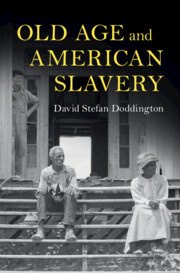Book contents
- Old Age and American Slavery
- Cambridge Studies on the American South
- Old Age and American Slavery
- Copyright page
- Dedication
- Contents
- Figures
- Tables
- Acknowledgments
- Introduction
- Part I The Enslaved
- 1 “As to those more advanced in life”
- 2 “Old and broken now; no tongue can tell how much I suffer”
- 3 “Young people think that old people are fools but old people know that young people are fools”
- 4 “Don’t kill such an old creature as I”
- 5 “You wont notice me now but you’ll wish you had”
- 6 “The summer of my life was passing away”
- Part II Enslavers
- Bibliography
- Index
4 - “Don’t kill such an old creature as I”
Old Age and Community Tension
from Part I - The Enslaved
Published online by Cambridge University Press: 27 October 2023
- Old Age and American Slavery
- Cambridge Studies on the American South
- Old Age and American Slavery
- Copyright page
- Dedication
- Contents
- Figures
- Tables
- Acknowledgments
- Introduction
- Part I The Enslaved
- 1 “As to those more advanced in life”
- 2 “Old and broken now; no tongue can tell how much I suffer”
- 3 “Young people think that old people are fools but old people know that young people are fools”
- 4 “Don’t kill such an old creature as I”
- 5 “You wont notice me now but you’ll wish you had”
- 6 “The summer of my life was passing away”
- Part II Enslavers
- Bibliography
- Index
Summary
Leisure time and social affairs were of paramount importance for enslaved people; in these spaces they developed positive personal identities and meaningful relationships with others. The significance of competition in leisure activities, however, with its attendant emphasis on contest, and even conflict, meant the identities forged in these spaces were neither static nor fixed in time. Competition involves putting your reputation on the line and, regardless of any sense of shared honor through participation, to lose is to be publicly revealed as having been mastered by another. Enslaved people who had valued their physical prowess or mental aptitude as allowing them to demonstrate themselves as the best in the community might struggle in the face of challenges from younger rivals or simply from time itself. Younger members of the community might see in their elders a rival to supplant, and, in doing so, a hierarchy they might stand atop. Such conflicts demonstrate the necessity of intersectional analysis when exploring enslaved social dynamics and identities, wherein age must be incorporated as much as the well-studied categories of gender, class, and race.
Keywords
- Type
- Chapter
- Information
- Old Age and American Slavery , pp. 136 - 163Publisher: Cambridge University PressPrint publication year: 2023

